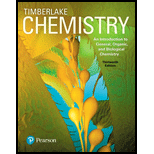
Modified Mastering Chemistry with Pearson eText -- Standalone Access Card -- for Chemistry: An Introduction to General, Organic, and Biological Chemistry (13th Edition)
13th Edition
ISBN: 9780134562254
Author: Karen C Timberlake
Publisher: PEARSON
expand_more
expand_more
format_list_bulleted
Concept explainers
Question
Chapter 5, Problem 5.81CP
Interpretation Introduction
To determine:
The complete
Expert Solution & Answer
Want to see the full answer?
Check out a sample textbook solution
Students have asked these similar questions
Construct a molecular orbital diagram for carbon monoxide. Identify the relevant point group,include all of the appropriate symmetry labels and pictures, and fill in the electrons. Make sure toaccount for the difference in electronegativity between C and O. Hint: CO is substantiallyisoelectronic to N2. (PLEASE DRAW THE ENTIRE MO DIAGRAM!!!)
please help with hw
help me solve this hw
Chapter 5 Solutions
Modified Mastering Chemistry with Pearson eText -- Standalone Access Card -- for Chemistry: An Introduction to General, Organic, and Biological Chemistry (13th Edition)
Ch. 5.1 - Prob. 5.1PPCh. 5.1 - Prob. 5.2PPCh. 5.1 - Naturally occurring potassium consists of three...Ch. 5.1 - Naturally occurring iodine is iodine-127....Ch. 5.1 - Identify each of the following: a. 10X b. 24X c....Ch. 5.1 - Identify each of the following: a. 11X b. 3581X c....Ch. 5.1 - Prob. 5.7PPCh. 5.1 - Prob. 5.8PPCh. 5.1 - Prob. 5.9PPCh. 5.1 - Prob. 5.10PP
Ch. 5.1 - Prob. 5.11PPCh. 5.1 - Prob. 5.12PPCh. 5.2 - Prob. 5.13PPCh. 5.2 - Prob. 5.14PPCh. 5.2 - Prob. 5.15PPCh. 5.2 - Prob. 5.16PPCh. 5.2 - Prob. 5.17PPCh. 5.2 - Prob. 5.18PPCh. 5.2 - Prob. 5.19PPCh. 5.2 - Prob. 5.20PPCh. 5.2 - Complete each of the following reactions: a....Ch. 5.2 - Prob. 5.22PPCh. 5.3 - Prob. 5.23PPCh. 5.3 - Prob. 5.24PPCh. 5.3 - Prob. 5.25PPCh. 5.3 - Prob. 5.26PPCh. 5.3 - Prob. 5.27PPCh. 5.3 - Prob. 5.28PPCh. 5.4 - Prob. 5.29PPCh. 5.4 - Prob. 5.30PPCh. 5.4 - Prob. 5.31PPCh. 5.4 - Prob. 5.32PPCh. 5.4 - Prob. 5.33PPCh. 5.4 - Prob. 5.34PPCh. 5.5 - Prob. 5.35PPCh. 5.5 - Prob. 5.36PPCh. 5.5 - Prob. 5.37PPCh. 5.5 - Prob. 5.38PPCh. 5.5 - Prob. 5.39PPCh. 5.5 - Prob. 5.40PPCh. 5.6 - Prob. 5.41PPCh. 5.6 - Prob. 5.42PPCh. 5.6 - Prob. 5.43PPCh. 5.6 - Prob. 5.44PPCh. 5.6 - Prob. 5.45PPCh. 5.6 - Prob. 5.46PPCh. 5.6 - Prob. 5.47PPCh. 5.6 - Prob. 5.48PPCh. 5.6 - Prob. 5.49PPCh. 5.6 - Prob. 5.50PPCh. 5 - Prob. 5.51UTCCh. 5 - Prob. 5.52UTCCh. 5 - 5.53 Draw the nucleus of the isotope that is...Ch. 5 - Prob. 5.54UTCCh. 5 - Prob. 5.55UTCCh. 5 - Prob. 5.56UTCCh. 5 - Determine the number of protons and number of...Ch. 5 - Determine the number of protons and number of...Ch. 5 - Prob. 5.59APPCh. 5 - Prob. 5.60APPCh. 5 - Prob. 5.61APPCh. 5 - Prob. 5.62APPCh. 5 - Prob. 5.63APPCh. 5 - Prob. 5.64APPCh. 5 - Prob. 5.65APPCh. 5 - Prob. 5.66APPCh. 5 - Prob. 5.67APPCh. 5 - Prob. 5.68APPCh. 5 - Prob. 5.69APPCh. 5 - Prob. 5.70APPCh. 5 - Where does fusion occur naturally? (5.6)Ch. 5 - Prob. 5.72APPCh. 5 - Prob. 5.73APPCh. 5 - Prob. 5.74APPCh. 5 - Prob. 5.75APPCh. 5 - Prob. 5.76APPCh. 5 - Prob. 5.77APPCh. 5 - Prob. 5.78APPCh. 5 - Prob. 5.79CPCh. 5 - Prob. 5.80CPCh. 5 - Prob. 5.81CPCh. 5 - Prob. 5.82CPCh. 5 - Prob. 5.83CPCh. 5 - Prob. 5.84CPCh. 5 - Prob. 5.85CPCh. 5 - Prob. 5.86CPCh. 5 - Prob. 5.87CPCh. 5 - Prob. 5.88CPCh. 5 - Prob. 5.89CPCh. 5 - Prob. 5.90CP
Knowledge Booster
Learn more about
Need a deep-dive on the concept behind this application? Look no further. Learn more about this topic, chemistry and related others by exploring similar questions and additional content below.Similar questions
- Briefly explain chemical potential.arrow_forwardReason whether it is possible to determine changes in the Galvani potential difference at the metal-solution interface.arrow_forwardObtain the standard potential at 25°C of the Cu* I Cu | Pt electrode from the standard potentials E° Cu²+/Cu = 0.341 V and E Cu²+ /Cu+ = 0.153 V.arrow_forward
arrow_back_ios
SEE MORE QUESTIONS
arrow_forward_ios
Recommended textbooks for you
 ChemistryChemistryISBN:9781305957404Author:Steven S. Zumdahl, Susan A. Zumdahl, Donald J. DeCostePublisher:Cengage Learning
ChemistryChemistryISBN:9781305957404Author:Steven S. Zumdahl, Susan A. Zumdahl, Donald J. DeCostePublisher:Cengage Learning ChemistryChemistryISBN:9781259911156Author:Raymond Chang Dr., Jason Overby ProfessorPublisher:McGraw-Hill Education
ChemistryChemistryISBN:9781259911156Author:Raymond Chang Dr., Jason Overby ProfessorPublisher:McGraw-Hill Education Principles of Instrumental AnalysisChemistryISBN:9781305577213Author:Douglas A. Skoog, F. James Holler, Stanley R. CrouchPublisher:Cengage Learning
Principles of Instrumental AnalysisChemistryISBN:9781305577213Author:Douglas A. Skoog, F. James Holler, Stanley R. CrouchPublisher:Cengage Learning Organic ChemistryChemistryISBN:9780078021558Author:Janice Gorzynski Smith Dr.Publisher:McGraw-Hill Education
Organic ChemistryChemistryISBN:9780078021558Author:Janice Gorzynski Smith Dr.Publisher:McGraw-Hill Education Chemistry: Principles and ReactionsChemistryISBN:9781305079373Author:William L. Masterton, Cecile N. HurleyPublisher:Cengage Learning
Chemistry: Principles and ReactionsChemistryISBN:9781305079373Author:William L. Masterton, Cecile N. HurleyPublisher:Cengage Learning Elementary Principles of Chemical Processes, Bind...ChemistryISBN:9781118431221Author:Richard M. Felder, Ronald W. Rousseau, Lisa G. BullardPublisher:WILEY
Elementary Principles of Chemical Processes, Bind...ChemistryISBN:9781118431221Author:Richard M. Felder, Ronald W. Rousseau, Lisa G. BullardPublisher:WILEY

Chemistry
Chemistry
ISBN:9781305957404
Author:Steven S. Zumdahl, Susan A. Zumdahl, Donald J. DeCoste
Publisher:Cengage Learning

Chemistry
Chemistry
ISBN:9781259911156
Author:Raymond Chang Dr., Jason Overby Professor
Publisher:McGraw-Hill Education

Principles of Instrumental Analysis
Chemistry
ISBN:9781305577213
Author:Douglas A. Skoog, F. James Holler, Stanley R. Crouch
Publisher:Cengage Learning

Organic Chemistry
Chemistry
ISBN:9780078021558
Author:Janice Gorzynski Smith Dr.
Publisher:McGraw-Hill Education

Chemistry: Principles and Reactions
Chemistry
ISBN:9781305079373
Author:William L. Masterton, Cecile N. Hurley
Publisher:Cengage Learning

Elementary Principles of Chemical Processes, Bind...
Chemistry
ISBN:9781118431221
Author:Richard M. Felder, Ronald W. Rousseau, Lisa G. Bullard
Publisher:WILEY